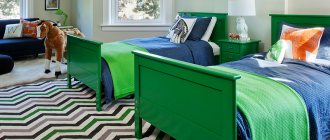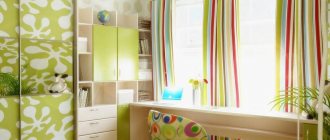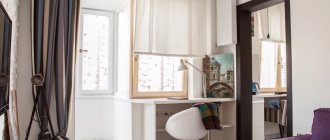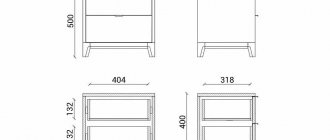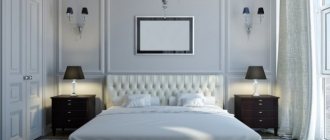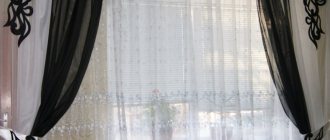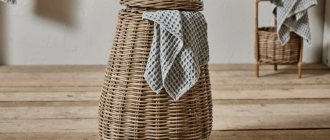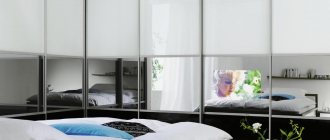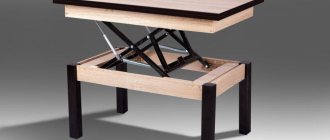When buying a children's bed, one of the main criteria is the dimensions of the furniture. Selecting the right model in size and height will provide your child with the comfort and safety that is important to him.
When planning to buy furniture for a child’s sleep, you need to pay attention to such parameters as the height of the children’s bed, its length and width. The variety of models presented in the store will make it easy to choose an option with suitable dimensions for the correct arrangement of a full-fledged sleeping place, depending on age.
Basic parameters for choosing a children's bed
Not only his comfort, but also his health directly depends on how correctly a bed is chosen for a child. When purchasing, experts suggest parents focus on the following parameters:
- Age appropriate
Depending on the age of the children, different requirements may be imposed on the sleeping place, and first of all, on its dimensions. The height of the bed for a child should allow him to easily get down and get into it on his own without the risk of falling, and the length and width should correspond to his height and build.
- Safety
Safe children's furniture is a high-quality assembly, durable and strong design, as well as the complete absence of components and elements that the child risks getting hurt or hit hard - such as noticeably protruding bases, sharp corners and lattice sides in which the baby's hand or leg can get stuck. . Also, such beds should not have complex mechanisms that children are unlikely to be able to handle on their own, and when purchasing, you must carefully check the selected model for damage, cracks and chips.
- Environmental friendliness
The quality of materials is another strict criterion in choosing a bed for a child. Responsible manufacturers use only raw materials that meet strict environmental safety requirements - their furniture is usually made from natural solid wood or high-quality MDF or plastic without dangerous additives, and only non-toxic hypoallergenic varnishes and paints are selected for painting. To be sure of the right choice, you can ask the seller for documents and certificates for the bed - the E0 or E1 marking indicated in them indicates that the model meets all the above requirements.
In some cases, adults select a bed based on the size of the children's room, color and design. These criteria are also relevant, but the comfort and health of the child must be taken into account first.
Frame material
Despite the fact that for the manufacture of any types of children's furniture, including bedroom furniture, the best material is natural wood (solid wood, boards, bars, slats), most budget options for cribs are made on the basis of chipboard (chipboard) or medium density fibreboard (MDF panels ).
Coniferous wood is usually used to make children's beds, but products made from hard wood - ash, maple, beech - are more preferable.
Quite popular are samples made in a combined version, when laminated chipboard or MDF panels are used for walls and panels, and load-bearing, frame structures are made of wooden blocks, boards or slats. Today on the children's furniture market there are quite a lot of combined models that combine metal and wood, wood and plastic, or all three of these materials at the same time. Thanks to this technique, it is possible to obtain samples of a fairly original design that have a very affordable price.
When choosing a specific model, you should pay attention to the design of the base for the mattress. The solid bottom used in some models, even if equipped with ventilation holes, cannot be considered the best option. A more acceptable design for the mattress base is considered to be slatted or sieve, which provides excellent ventilation of the mattress. When equipping a children's bed with an orthopedic mattress, in the vast majority of cases, a sieve bottom made of rounded, solid wooden slats is used.
When should you change your child's bed?
Sleeping places for children need periodic updating, and therefore sooner or later the child will need another bed. Furniture must be replaced in the following cases:
- The child grows up
This process is natural and inevitable, and therefore, from the moment the baby is born, it is necessary to plan to replace the bed in a few years. As children grow and develop, the dimensions of the furniture change according to the following principles:
- From 3 years.
For a young child, it is necessary to increase the length of the bed to 140-145 cm, while the height of the children's bed from the floor also changes by at least 30 cm upward. - 7-10 years.
For a primary school student, a length of 160 cm and a width of at least 80 cm will be required. The height can be left the same or increased by 10-20 cm if you plan to place drawers for linen or toys under the bed. - Children 10 years and older.
Schoolchildren and teenagers will be provided with comfort by a bed with a minimum size of 90x180 cm and a height of 50 cm. Adult single beds also have the same dimensions, so your child can choose an option in any model range. - There has been a sudden change in the child's height or weight
In this case, a change of bed will be required before moving to the next age stage. Selecting furniture based on standard criteria can be quite risky, so you should focus on individual parameters: if the child stretches out quickly, you need to add at least 30-35 cm to his height, and from 15 cm to his width.
- The child became uncomfortable
Inconvenience can be caused not only by changes in weight and height, but also by subjective reasons - because of the high sides he is unable to climb into the bed on his own, the low headboard does not allow him to get comfortable, or due to too active games in the room he often hits parts of furniture. In this case, it is important to select a model as soon as possible, based on the individual needs of the child, otherwise poor sleep quality will affect his well-being.
- The bed is damaged
If breaks and cracks appear on the body or base, parts of the bed become loose or fall off, replacement is necessary as soon as possible, and primarily for safety reasons.
Safety
The main safety factors for a child's bed are provided by:
- high placement of the mattress base (grid) guaranteeing free and comfortable servicing of the sleeping baby by parents;
- Let's call for enclosing sides or bars to prevent the child from falling off the mattress during restless sleep.
It is especially important to have a fence for a baby who is learning to stand up. It serves as a support, clinging to which to develop the technique of climbing and maintaining balance. After the child begins to sleep peacefully and confidently crawls and stands on his feet, the fence can be removed.
The main safety requirements for the design of sides are:
- dimensions length and height, which are chosen taking into account the age and character (restlessness) of the child - for a baby who has begun to walk independently, their length is usually equal to one third of the length of the bed;
- the stability and rigidity of the fence should prevent it from spontaneously tipping over or opening under the weight of a child;
- The ideal materials for the manufacture of sides are natural wood, upholstered in environmentally friendly drapery fabric with filler;
- All fences must have rounded corners and contours and blunt edges.
Standards and sizes of children's beds
The dimensions of children's beds are determined not only by age, but also by the design of the models. Today in Moscow you can buy various options - but no matter which one suits the taste of parents and children, it is important first of all to pay attention to the sizes.
Children's beds from 0 to 3 years
Manufacturers offer models of various configurations for children from birth to 3 years. For a standard crib, clear dimensions are established - from 60x120 cm, the maximum height of the sides is 95 cm. If the sides are lattice, the permissible distance between the bars is 7.5 cm.
Playpen bed
Safe and functional bed models for babies, in which they can play and relax even as they grow older. As a rule, they have fully mesh or fabric sides with mesh windows on a lightweight metal frame. The recommended minimum dimensions of such beds are 120x70 cm.
Add-on bed models
A distinctive feature of side beds is a removable sidewall, in the absence of which it can be placed close to the parents’ sleeping place. As a rule, their dimensions are smaller than standard ones - width is about 55-60 cm, length - 90 cm, height - 30-50 cm, and the size of the sides is up to 80 cm. It is important that the height exactly corresponds to the same parameter of an adult bed in avoid injury and discomfort.
Transformable beds
Such models are a complex modular design, which, in addition to a bed, includes a chest of drawers, a changing table and drawers for linen. As the child grows, the sides are removed, the height of the base is adjusted from 30 to 50 cm, and the remaining modules turn into bedside tables and hanging shelves, without which the model for a baby transforms into a teenage bed. The dimensions of such furniture vary in the range of 160-200 cm in length and 60-80 cm in width, so a quality product can last 10-12 years, providing the child with the necessary comfort.
For preschoolers and schoolchildren
The sizes of bedroom furniture for preschool children and schoolchildren vary between 140-170 cm in length and 60-80 cm in width. In this case, the height of the head of the children's bed also plays an important role - it should protrude upward by at least 40 cm from the mattress, otherwise it will be uncomfortable for the child to settle down to sleep.
For teenagers
Teenage beds are almost the same size as adults - from 180 cm in length, from 80-90 cm in width with an average height of 50 cm. Buying a sliding bed can also be a reasonable solution, since the child continues to grow little by little until graduation.
Bunk beds
Children's bunk beds can be of two types:
- With upper sleeping and lower play area. The standard size of this model is 90x190 cm.
- With two sleeping areas. In this case, the length of the bed can be up to 200 cm and the width up to 110 cm.
The height of a bunk bed for children is a key selection criterion, which even affects the cost of products. Most models are made in the range of 1.5-1.8 m, although you can also find models 1.4 m high with a roll-out lower tier.
Custom beds
Models of non-standard beds include:
- Beds for twins
. Their standard size is 135x125 cm. Such beds are used until children turn 4-5 years old, after which they are changed to two single beds or a bunk model. - Designer models
. Beds in the form of cars, castles, ships, as a rule, have sleeping places that meet the standards. However, before purchasing, you must take measurements to be sure. - Beds of non-standard length
. Such models are often made to order for tall teenage children.
Cradles
This type is very popular among parents who want to create comfortable conditions for themselves and their children. Such a model can be equipped with an arc with toys, a visor, wheels and other elements, but the main feature is a manual or automatic motion sickness system.
Typically, such models are intended for babies up to 8-12 months, so their length does not exceed 85-95 cm and width 50 cm. When the baby is 8-12 months old, the crib will have to be changed to another.
The disadvantage of such models is that they do not have proper stability. This must be taken into account during operation.
A simple cradle that can independently rock a newborn, supporting a weight of up to 20 kg.
Tips for choosing a mattress, mattress pad, pillow, textiles
In addition to the bed, bedding, which is chosen according to certain criteria, is also responsible for a child’s healthy and restful sleep.
- Mattress
. In size, they must fully correspond to the dimensions of the sleeping place without deformation or the formation of cracks. The height of the mattress for a children's bed is no less important. If for babies this parameter is 6-8 cm, then with each age stage it can be increased by 2-3 cm. As for materials, orthopedists recommend fillers of moderate and high hardness. - Pillow.
Newborns do not require a pillow. However, as you grow, it is necessary to select options that ensure a healthy body position and comfort during sleep - not too hard and high, made from safe hypoallergenic materials. The pillow needs to be changed every 2-3 years. - Textile.
The best option is bed linen made from fabrics with a high content of natural cotton. At the same time, it is necessary to select it exactly according to the size of the pillow and blanket so that the pillowcase and duvet cover do not bunch up or roll down.
Obviously, the selection of a children's bed and bedding depends on many factors. That is why it is important to select furniture slowly, carefully studying each option for comfort, quality and safety. It’s also not worth saving on such things: good sleep ensures good health and proper development of the child.
SON.ru will help you with your choice
Our specialists are the best experts in matters of comfortable sleep and are always ready to help you. We are in touch and will answer all questions. The consultation is absolutely free.
Key points to consider before purchasing
First of all, a sleeping place for a newborn, regardless of the chosen model and type, must be completely safe, which means that:
- The crib must be stable in any mode and position so that the child does not fall out. If parents think that the baby is not even getting up yet and there is no danger, then this is a mistaken opinion. Since the baby can make the first lifts without their participation and immediately roll over and fall out;
- The bottom should not sag, since the most correct body position for newborns is ensured either on the mother’s arms or on a flat hard surface, which guarantees free blood flow, breathing and stability of digestive processes;
- There are no sharp corners, protrusions, roughness or similar imperfections that could damage the baby’s delicate skin;
- The paint and adhesive materials contain no toxic substances.
Next, check all the connecting elements and the structure itself, pay attention to the following points:
- The bottom must be solid and adjustable. Please note that the slats provide better ventilation of the mattress;
- The presence of a removable side allows you to use the bed as a support bed for an adult, so the mother will always be nearby and will be able to breastfeed the baby without worrying that she will lie on him, etc.;
- The ideal distance between the rods (in classic models and transformers) is 7-8 cm; if it is less, an arm or leg may get stuck; if it is more, the baby will definitely try to stick his head through. And the consequences are already different, but rarely without the help of parents, few people returned to the normal position, since the ears prevent them from getting back out;
- Reliability of all fastenings;
- Availability of wheels if you need to change location frequently.
Secrets of the label
The markings on bed linen labels were developed by the International Organization for Standardization and serve as a guide to maintaining the product.
The decoding refers to 4 care processes:
- washing (machine or hand) is indicated by a bowl of water icon indicating the permitted temperature conditions
- drying in an automatic machine is depicted by a circle inscribed in a square;
- bleaching is marked by a triangular shape;
- ironing is symbolized by an iron indicating the permitted temperature conditions.
The label also indicates the manufacturer, sizes, raw materials of fabrics and accessories. Using the information on the label, you can increase the service life of bed linen, maintain its good condition and performance properties.
With the help of a beautifully designed crib and soft-touch bedding of appropriate sizes, you can teach your child to follow a daily routine from birth. When choosing bedding, you must be guided, first of all, by the principles of safety and quality of products.
Article design: Oleg Lozinsky
How to choose children's bedding, which is better?
The bed linen segment is presented on the market in the form of sets and individual products.
Textiles for sewing children's accessories must meet the requirements:
- high degree of hygiene;
- good color fastness
- hygroscopicity;
- ease of care;
- hypoallergenic;
- wear resistance;
- breathability;
- softness.
Natural fabrics include:
- cotton;
- poplin;
- ranfors;
- satin;
- silk;
- linen;
- chintz;
- calico
Advantages of classic dimensions
Classic dimensions: 120 by 60 by 100 cm are very convenient, because the crib can be placed in the smallest room, it can be conveniently placed next to the parent’s bed, and this crib is easy to move.
The simple design also allows you to hide various things under it for the child. These could be children's toys, some things or a bath for small children. The last option is one of the optimal ones; as a rule, the bathtub has approximately the same dimensions as the bed, so it can easily be hidden under the bottom of the crib.
In addition to all the advantages that regular children's beds have, there are also wheels that can be removed when not needed, and in this case it turns into a rocking chair. It turns out that it can be rocked and this helps to lull the baby to sleep.
Classic models are equipped with a standard side on one side, which can be lowered slightly or raised to its full height for convenience. In more expensive models, this parameter often differs in that the side is completely open or closed. It cannot be said that this is very practical, since leaving the child alone requires closing this side every time. So the classic dimensions and designs of a crib are much better and more reliable than expensive models.
Now let's look at cribs of more expensive models. What are their advantages? Let's start with the appearance. Its style can differ greatly from two simple properties - the color of the paint with which it is covered and the unusual shape of the parts. Also, the design of the crib may differ radically from classic models. For example, there are models on sale where the crib is close to the adult bed, which allows mother and baby to be very close, and at the same time the parents remain on their adult bed, and the baby on his own, without complicating the situation for the adults. Of course, such models will cost significantly more than standard, classic ones.
Attention! When buying a crib for a baby, do not forget about the need to buy a mattress. Its dimensions must correspond to the dimensions of the crib.
Custom beds are often equipped with features such as built-in pull-out drawers for toys. This is very practical and it fits perfectly into the overall interior of the room, where there is other furniture.
Returning to the topic of the advantages of conventional models, it should be noted that such models are very inexpensive and over time, after the baby grows up, you can always replace the classic model with a more expensive teenage model. In other words, you can save now on a teenage bed in the future.
The standard design of classic cribs is always easy to repair if damaged, and parts for its repair are very easy to find. Standard dimensions will always be an advantage, as they will suit any newborn baby.
Everyone chooses for themselves which model to buy for their future baby. The choice depends on such items as budget (price), sizes (standard or non-standard) and design (conventional design or with additional elements). Based on these three points, you need to start when choosing a children's bed.
Important! When purchasing, do not forget about such important additional attributes as a soft mattress, winter blanket, diapers, rattles, pillow and baby bath.
The issue of choosing such furniture is in most cases decided in favor of classic dimensions and, less often, in favor of classic design. It is difficult to say unequivocally how important the style or its size is, but the most important thing is the comfort of the baby who will be born.
Materials from which cribs are made
In the first months of life, the baby sleeps about 18 hours a day. Growing up, he begins to explore the world, tasting all objects. That is why everything that surrounds it must be made of safe materials - without harmful substances, pungent odor or taste.
Tree
Solid wood is perhaps the best option for the first crib. This is a durable natural material that allows air to circulate and looks very cozy. Most often, birch, alder, oak or beech are used for the production of children's furniture, which are highly resistant to mechanical damage. However, untreated wood absorbs moisture well, which can lead to its rotting, so wooden furniture is treated with special means. For cribs, safe water-based varnishes and paints are used, without lead and formaldehyde.

